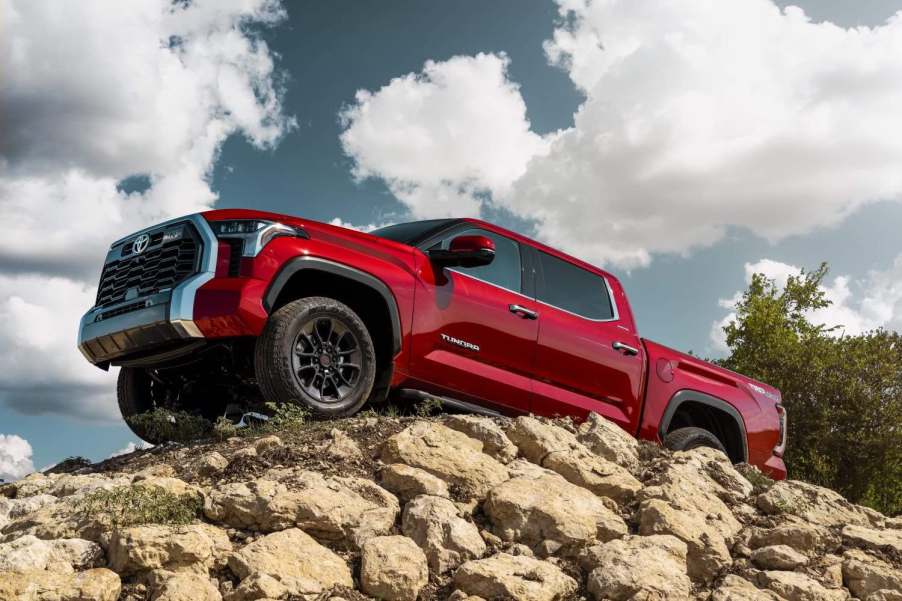
Here’s the Surprising Way Ford Inspired the Toyota Tundra’s Name
Some facts are stranger than fiction. For example, the Toyota Tundra would not have its name if it weren’t for the Ford F-150. When Toyota redesigned its T100, it considered calling the new truck the T150. That is until Ford threatened a lawsuit. The result was Toyota pivoting to the Tundra name we’re all familiar with. But the Ford lawsuit was ridiculous and would have likely failed for one unexpected reason.
Here’s the story behind the Toyota Tundra’s name

Since introducing the 1958 Land Cruiser, Toyota has sold millions of trucks and SUVs worldwide. The automaker first tried to break into the U.S. truck market with the 1964 Toyota Stout but only sold four units that year.
In 1969, Toyota launched a new truck aimed at the United States market: the HiLux. In 1974, the redesigned HiLux was named “Pickup Truck of the Year” by the Pickup, Van & 4WD magazine. Over the decades, the automaker dropped the HiLux name and simply called its model the “Toyota Truck.” When it decided to launch a slightly larger V6 pickup in 1993, it named its second truck model the T100 to avoid confusion.
For the 1995 model year, Toyota debuted a fully redesigned smaller truck and renamed it the Tacoma. Then, for 1999, it redesigned the T100 to transform it into a proper full-size pickup truck. The automaker offered a longer cab with clamshell rear doors and the first i-FORCE V8. To clarify that this was an all-new truck in a new segment, it decided to change its name from T100 to T150. But Ford had other ideas.
Here’s the story behind the Ford F-150 and Ford’s Toyota lawsuit

Ford first introduced the “F-Series” pickup truck naming convention in 1948 with its “Bonus-Built” line. These were the first Ford trucks that did not share a chassis with the company’s full-frame cars. They were all manuals, and the biggest engine was a 317 cubic-inch V8. But there was no F-150 in this lineup. Their names ranged from the F-1 to the F-8, depending on GVWR.
When Ford introduced the second generation of its trucks for the 1953 model year, it stretched the F-series names to three digits. The half-ton became the F-100. Like today, the 3/4-ton was the F-250, and the 1-ton was the F-350. But the larger trucks dropped the 50, so the 1.5-ton was the F-500, the 2-ton the F-600, then F-700, F-750, F-800, and F-900. Why did some end in 00 and others in 50? Beats me.
It wasn’t until 1975 that Ford slotted an “F-150” in between its F-250 and still popular F-100. And it was 1983 when Ford finally dropped the F-100 altogether, making the F-150 its only half-ton truck. Just 12 years later, Ford got wind of a possible T150 and threatened legal action to protect its model name (according to WideOpenRoads.com). But Ford forgot one thing.
Ford was not the only brand to use 150 in its truck names

Dodge first introduced its “D/W” series of pickup trucks in 1960. The automaker began 2WD model names with a D and 4WDs with a W (because…Power Wagon). Like Ford, it used three-digit numbers to represent truck classes (D-100, D-200, etc.). The D-100 and F-100 coexisted for decades without Ford suing Dodge.
In 1981, Dodge completed a significant redesign of its pickup truck line. To differentiate the new trucks, it named them all “Dodge Rams” (or Dodge Power Rams in the case of the 4WDs because…Power Wagon). It also bumped each model number up by 50. So the Dodge D-100 became the Dodge Ram D150, etc.
Remember, at this point, the Ford F-150 did exist, although it wasn’t the brand’s only light-duty truck because Ford was still selling the F-100. But if Ford wanted to set the precedent that it had the rights to all truck names ending in “150,” it needed to have sued Dodge back in 1981. And it did not.
At this point, Chevrolet still used two-digit numbers for its truck models. It was in 1988 that Chevy jumped right over three-digit numbers and released its first C/K1500. Like with Dodges, C trucks were 2WD while K trucks were 4WD. What’s interesting is that its “professional grade” cousin, the GMC pickup, had been using “1500” on certain trucks since 1960.
In 1994, Dodge again inflated its model numbers, adding another 0. So the Dodge Ram D-150 became the Dodge Ram 1500 and caught up with the General Motors trucks.
By the time the Toyota T100 began transforming into the T150, the only other truck ending in 150 was the Ford. If you ignored the fact that Dodge had used the same convention for a generation–or the fact that Dodge and GM shared 1500 without any trouble–you might convince yourself that Ford had some kind of rights to “150.” But Ford’s supposed Toyota lawsuit was a flimsy threat at best.
Toyota obviously didn’t see things this way. The automaker dropped its T150 name and found the perfect name to compliment its existing Tacoma: the Toyota Tundra. The rest, as they say, is history.
Next, learn about the old ‘Chicken Tax’ that shaped the hi-lux and is making EVs more affordable, or see a comparison of the first Tundra and contemporary F-150 in the video below:






